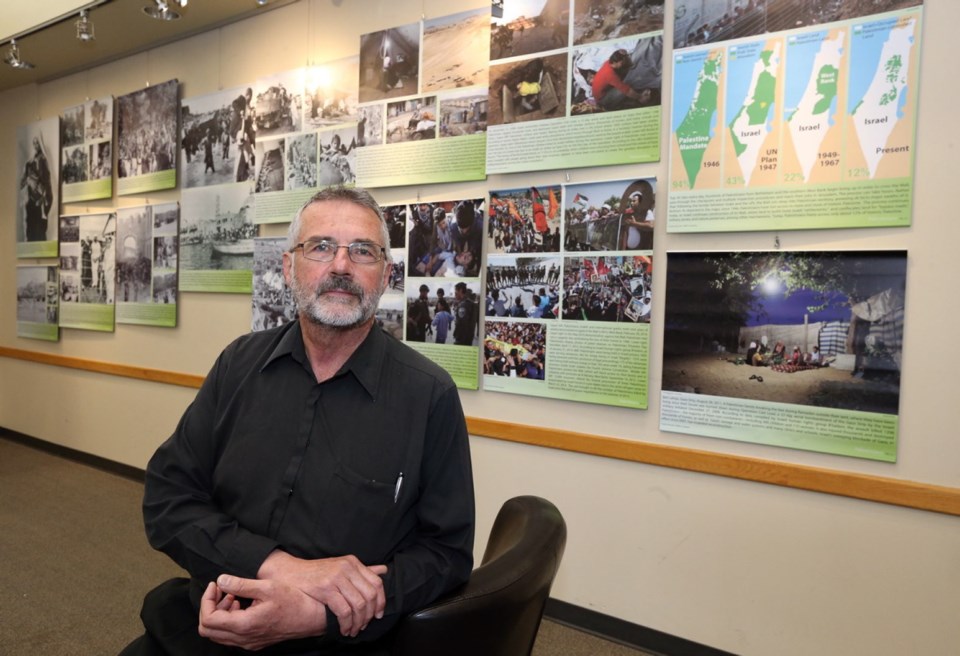The Community Arts Council of Greater Victoria will keep a controversial photo exhibition up, despite receiving indirect threats of violence and vandalism.
Its president, Bob Williams, said the council and the Cedar Hill Recreation Centre, which lends the council exhibition space, received multiple calls on Wednesday and Thursday.
“Their voices were calm but they were indicating that, yes, they’d seen the exhibition and they were concerned about it,” Williams said of the callers. “[They were] suggesting that some of the content of the exhibition could incite people to vandalism against the exhibition and the building and, worse still, that it could generate some violence in the community.”
The exhibition, called Dispossessed, but Defiant: Indigenous Struggles from Around the World, opened Thursday night without incident. It was organized by Toronto-based group Canadians for Justice and Peace in the Middle East.
It features photos by professional and amateur photographers taken in three regions of the world.
The show has been criticized by some members of the Jewish community for misrepresenting Israel, by equating the plight of Palestinians following the 1948 Arab-Israeli war with that of First Nations in Canada and blacks in South Africa.
“It’s not even-handed,” said Harry Abrams, a Victoria businessman who is also the Victoria representative for the League for Human Rights of B’nai Brith Canada. Abrams said he had no knowledge of the threats.
“I would abhor people doing that,” he said. “If anything, threats of that nature are antithetical to what I’m certainly trying to do and represent.”
But he said the exhibition is problematic for the way it represents Israelis as colonizers, rather than people indigenous to the area returning to their land. The exhibit is an act of “protest” that discourages working together for a two-state solution, he said.
“If anything, it’s all pointing in one direction, which is hatred against the existence of Israel and Jews. … What it does is foster terror and hatred and distortion.”
Abrams said the exhibition ignores any aggression on the parts of Palestinians or Arab nations. It also fails to acknowledge peacemaking efforts on both sides or the long history of both Jews and Arabs living together in the region, instead identifying the area as “historic Palestine,” he said.
“There’s nothing about the fact that this refugee situation happened as a result of a war that was instigated by five Arab countries and the Palestinians themselves,” Abrams said.
Joan MacNeil, Toronto co-ordinator for the Canadians for Justice and Peace group, said the exhibition is about a common struggle. She asked the community arts council, which did not curate the show but arranged a venue, to respect its contract with Canadians for Justice and Peace and keep the show up.
“What we wanted to document is the concept of dispossession of indigenous people and how indigenous people have resisted those processes in different times and periods and places,” she said.
She gave examples such as losing land and having your movement restricted, and said Palestinians have experienced a disproportionate rate of civilian deaths.
“Certainly, there have been actions that violate international law on both sides, however the balance in terms of the number of victims is very clear. … The cost in terms of civilian life has overwhelmingly been paid by Palestinians,” MacNeil said.
Williams said this is the second show in the community arts council’s history to draw such extreme reactions; the first was a show relating to landmines two years ago.
It’s a fine balance trying to present art that’s interesting, which is sometimes challenging without being disrespectful, he said.
“Based on the information we received from the show’s organizers, it seemed to pass all the tests,” he said.
“We’re very concerned about the fact that, inadvertently, we might be contributing to violence in the community or vandalism. So we’re still very anxious about that. Where we’re at now is thinking, well, let’s go day by day.”
Williams said the exhibit did not receive public funding, despite a line indicating “collaboration” with the municipality of Saanich and province of B.C. on posters. He said that indicates the community arts council’s institutional relationships, not those of the exhibitors.



